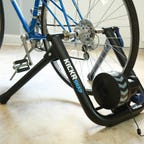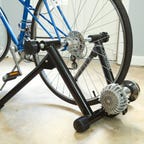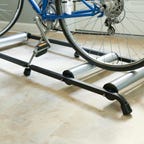Cycling is an excellent way to exercise, but with the seasons changing and temperatures dropping, outdoor cycling may not be ideal during the coming months. An indoor bike trainer is a great way to get your cycling sessions in at home when it’s too chilly to ride outdoors. Whether it’s the weather or a lack of time that’s keeping you home, indoor trainers can help keep those factors from spoiling your workout routine. The best wheel-on trainer options accommodate your riding style, cycling experience and training goals.
Indoor riding may not be easy to adjust to, but the best indoor bicycle trainers will bring you the feel of the road right at home, with realistic resistance, climbs and descents. Standard exercise or spin bikes don’t offer that but instead have progressive resistance and not much else to make you feel like you’re riding on the road. We’ve tested indoor bike trainers from top brands to find the best options for different cycling preferences and budgets.
What is the best indoor bike trainer overall?
Finding the best indoor bike trainer can be a lot of work since there are so many to consider. There’s the roller trainer, friction trainer, magnetic trainer, direct drive trainer and a simple stationary bike stand. If you want to go a little more high-tech, there are also a bunch of smart bike trainer options. I’ve scoured the internet, read cycle trainer reviews until my eyes started to cross and tested a variety of the top models to give you some guidance.
I’ve found indoor bike trainers for cyclists at different skill levels and with different budgets. Each of these selections has been thoroughly tested unless otherwise stated (I did include a small section of top options that we haven’t yet tested). Whether you’re brand new to indoor cycling or a pro looking to upgrade your cycling gear, you’ll find something here that fits.
Read more: 54 Best Christmas Gifts and Ideas for Every Price Range
Best indoor bike trainer for 2024
The Tacx Neo 2T Smart Trainer is not your grandmother’s indoor bike trainer stand. OK, your grandmother probably didn’t have a bike trainer, but my point is that this thing is intense — in all of the best ways. Although you can use the Neo 2T as a standalone trainer, I focused on testing its smart training capabilities by connecting it to the Tacx Training app, which is free for basic functions, but requires a monthly subscription of $10 to $14 to access premium features.
With the app, which is similar to Zwift, you can connect your trainer via Bluetooth and choose from several different workouts or “movies” that take you through simulated roads and inclines of up to 25%. The result was almost eerily realistic and provided some serious road feel. If I closed my eyes, I would have thought I was riding up the slopes of the Dolomites.
The trainer was super quiet, which is nice if you’re an early riser who wants to get some training in without waking up the rest of your house. While I don’t have the leg power or stamina to get up to the Neo 2T’s power cap of 2,200 watts, even at my high speeds, it stayed stable without any shaking at all.
There are some things you have to keep in mind with this trainer. The Neo 2T Smart trainer is the only one on this list that requires full removal of the back wheel and the cassette on your bike. To do the job properly, you need specialized tools. Another thing to note is that while the Tacx Neo 2T does come with several spacers to make your bike fit, it’s only compatible with certain cassette models. If you’re thinking of buying the Neo 2T, which retails at around $1,400, make sure you check the specs first and ensure that you have a compatible bike. Or, decide if you’re comfortable investing in a different bike.
While I had a positive experience with all of the indoor bike trainers on this list, if I had to pick just one, it would be the Wahoo Kickr Snap. The whole process was easy to follow. As someone who doesn’t have a lot of time to spare, an easy setup is always at the top of my list.
The trainer was ready to go right out of the box, with no assembly required. You do have to set up your bike — either with the included quick-release skewer or an appropriate adapter if your bike has a thru-axle rear wheel — but once you get the hang of it, it’s done in a snap (super cheesy pun intended). I do wish there was an option to choose which skewer you’d like included with the trainer (even if it costs a little bit extra), but this isn’t a knock on the Kickr Snap itself. It’s a gripe with all of these types of indoor bike trainers, in general.
Once the bike is up and in place, you can connect the trainer to any third-party training app. There’s a free 30-day trial of Zwift included with the purchase, so that’s the program I used to test the trainer. Once I got moving, I was immediately impressed. The 10.5-pound flywheel provided a smooth, quiet ride with a hyper-realistic road feel. When using Zwift, the resistance adjusted automatically and expertly mimicked actual road conditions and climbs of up to a 12% incline. As I picked up speed, the Kickr Snap stayed stable without any shaking and the front wheel riser block stayed firmly in place, even on a slippery-ish vinyl floor.
A few things to note: The trainer only comes with a quick-release skewer, so if you need an adapter for a thru-axle bike, you’ll have to buy it separately. The trainer is also the only one on this list that requires an external power source, meaning you have to plug it into an electrical outlet in the wall. While this wasn’t a deal-breaker, it is a potential downside since it limits the trainer’s portability. There’s also no on-off switch. You have to turn the trainer on and off by plugging it in or unplugging it. Again, it’s not a big deal since I like to unplug all of my electronics when I’m not using them anyway, but it’s still worth noting.
Alpcour isn’t as well-known as Wahoo or Saris in cycling circles, so when I saw that it had mostly 4- and 5-star reviews on Amazon and you could snag it for under $300, I had to test it out to see if it could stand against the bigger guys. Unlike other similar models on this list, it doesn’t have smart training capabilities so you can’t use it with any training apps. As far as basic performance goes, I was impressed.
Fluid bike trainers provide a stable, but outdoor-like ride and the Alpcour didn’t disappoint. The trainer was sturdy and held the bike firmly in place, even as I picked up speed. The resistance and friction automatically changed with fluctuations in my pedaling speed, so it really felt like an outdoor ride. The front wheel riser block did tend to slip a little while I rode, which wasn’t a major deal, but could get a little annoying. In all fairness, I had the trainer set up on vinyl flooring, which can get slippery. If it bothers you too much, you can easily rectify this by placing a thin rubber exercise mat underneath the bike trainer.
The Alpcour Fluid Bike Trainer was a little louder than the other similar trainers on this list, but it didn’t create enough noise for me to deduct any real points. The noise also depends on the type of bike you use. When I used my Schwinn road bike with smooth wheels, it was barely audible. When I tested it with my niece’s mountain bike which has thick, treaded tires, it was considerably louder.
While the trainer is compatible with most 26- to 29-inch bikes and 700c wheels, like with the Wahoo, you have to make sure you have the right skewer to properly attach your bike. Like the Wahoo, it comes with a standard quick-release skewer, but if you have a bike with a thru-axle, you’ll have to buy one separately.
I want to preface this by saying that the rollers may look the least technical on this list but don’t judge a book by its cover. Compared to all of the other models, the Saris Aluminum Rollers, which feature a 16-inch wheelbase that fits most bike sizes and three 3.25-inch aluminum roller drums, were the hardest to get used to.
That’s partly a reflection on me as a rider, and partly since roller trainers require more deliberate focus than other models. If you lose concentration and your mind starts to wander, you can easily fall right over; a situation I found myself in more times than I’d like to admit.
Roller trainers are made to help improve balance and control and after just a few days of practice and some serious frustration, I noticed a vast improvement in my performance, which is a testament to how well the trainer does its job. Since you have to pedal the whole time you’re using the trainer to keep the bike upright, you get a killer workout. Once I got the hang of the rollers and actually got moving, I was surprised at how quiet the rollers were and how firmly the rubber foot pads held the trainer in place, even as I picked up speed.
Another plus is that the rollers were practically ready to go right out of the box. All I had to do was unfold them and adjust the front roller so that it properly lined up with my bike and I was ready to ride (or fall over several times before I actually rode).
Recommended, but not yet tested
I haven’t had the chance to personally test the Kinetic Rock and Roll Trainer yet, but I included it on the list for several reasons. As its name implies, the Rock and Roll Trainer was designed to allow for a side-to-side rocking motion that mimics the natural sway of riding outdoors.
At 12 pounds, its flywheel is also larger than any other trainer in the category. According to Kinetic, this allows for automatic app-controlled resistance, whisper-quiet operation, a wider range of bike compatibility and improved inertia, which provides more of a road-like feel. While the maximum slope is slightly lower than the Wahoo Kickr Snap — 10% versus 12% — it goes up to a maximum resistance of 1,800 watts at 30 mph.
Because it’s a smart trainer, the Rock and Roll trainer works with Kinetic’s own training app or third-party apps, like Zwift or TrainerRoad. The Kinetic trainer is compatible with almost any bike, but, like other similar styles on this list, if your bike has a rear thru-axle, you’ll need an adapter that will cost you an additional $49.
This all sounds good, but when I get the chance to personally test the trainer, I’ll report back with my personal experience.
undefined
| Indoor Bike Trainer | Trainer type | Max power | Max incline | Weight (lbs) | Dimensions (inches) | Price |
|---|---|---|---|---|---|---|
| Tacx Neo 2T Smart Trainer | Direct drive | 2200 watt | 25% | 47.3 | 22.6 x 29.5 | $900 |
| Wahoo Kickr Snap | Flywheel | 1500 watt | 12% | 38 | 29 x 26 x 16 | $300 |
| Alpcour Fluid Bike Trainer | Fluid | N/A | N/A | 25.2 | 19 x 19 x 18 | $190 |
| Saris Aluminum Rollers | Roller | N/A | N/A | 6.5 | 33 x 21 x 7 | $300 |
| Kinetic Rock and Roll Trainer | Flywheel | 1800 watt | 10% | 36 | 27 x 26.75 x 11 | $513 |
I considered several different factors while looking for a quiet bike trainer that also offers several levels of resistance. I compared all the available options and found the best indoor bike trainers at several different prices. Then, I thoroughly tested them.
Trainer type: There are different types of indoor bike trainers to consider, including:
- Roller: While you can simply put your bike on the rollers and ride, this type of trainer requires more balance and technique. However, it is affordable and requires less setup.
- Friction: Allows you to keep your bike’s rear wheel on, applying resistance directly to the rear wheel. They are more affordable, but may not feel as realistic as other bike trainers.
- Magnetic: Creates resistance using a magnetic flywheel and magnets. A handlebar-mounted cable is usually used to adjust resistance.
- Direct drive: You remove your bike’s rear wheel and attach the trainer directly to your bike’s drivetrain. They tend to have a higher price tag, but can connect to apps and provide a more realistic ride feel.
- Flywheel: A disc-shaped device that connects to the pedals with a chain or belt.
- Fluid: A flywheel mechanism is driven by the bike’s rear wheel, but an impeller spinning in fluid inside the flywheel provides resistance. As you pedal faster, the temperature increases and causes the fluid to thicken, providing more resistance.
Road feel: Direct-drive bikes and those that connect to apps with simulated workouts can provide a more realistic road feel. However, these tend to be more expensive.
Size: Some indoor bike trainers can be folded and easily stored, while others require more space.
Assembly: Some bike trainers require less assembly, like rollers, while others may require you to remove your bike’s rear wheel. Depending on your bike, you may need to buy separate tools.
Your bike type: Before purchasing a bike trainer, you should always make sure that the bike trainer is compatible with your specific bike model.
Follow the specific user guides for your bike and bike trainer to make sure everything is installed correctly. A bike trainer isn’t necessarily bad for your bike, but it can put pressure on the components that come in contact with the trainer.
If you’re concerned about wear and tear, consider using an older or spare bike on the trainer and reserving your road bike for the road.
Whether or not it’s worth it to get a bike trainer depends on your cycling goals, the environment you live in and your budget. Do you want to train frequently and need to be able to fit in that training whenever is convenient? Do you live in a climate with weather that keeps you off the road or trail for long periods? Do you have the extra cash to devote to a trainer?
Those are all factors to consider before you buy. Weigh how often you think you’d use a bike trainer with their average price and decide if the value is there for you.
We like the Wahoo Kickr Snap trainer best for beginners. The setup is easy, it works with third-party apps (including a free month-long trial of Zwift) and it has a quiet ride that closely mirrors riding on the road.
Read more details about the Wahoo Kickr Snap in the best bike trainer for beginners section above.
A spin bike, also known as a stationary bike, can only be used in one place. It features a saddle, pedals and handlebars that are attached to a stationary base that keeps the bike in place while you pedal. As for a bike trainer or indoor trainer, it is designed to attach to a road or mountain bike to provide resistance. For the latter, there are multiple types, such as direct-drive, flywheel and roller trainers.
While indoor bike trainers can typically fit a wide range of bikes, you will need to check the bike trainer specifications to ensure that it will fit your specific bike.








